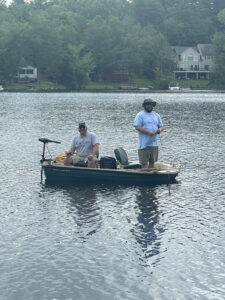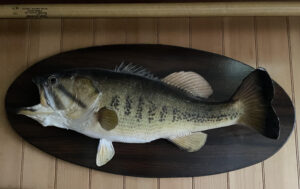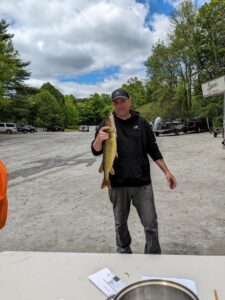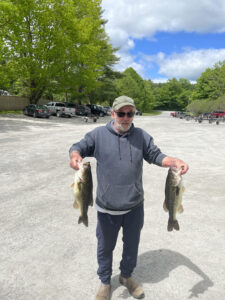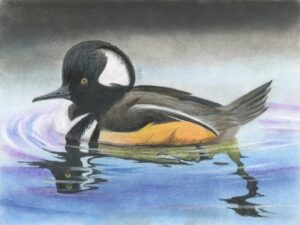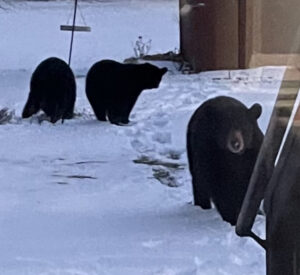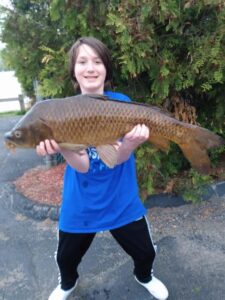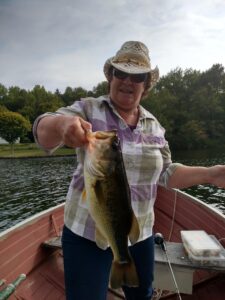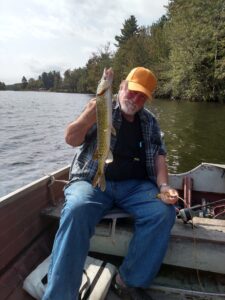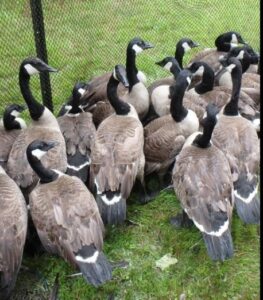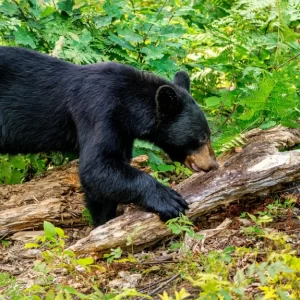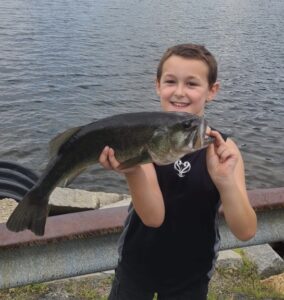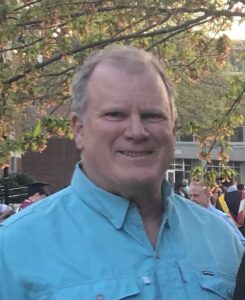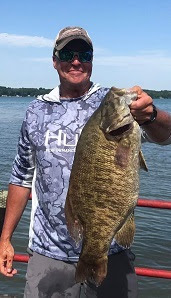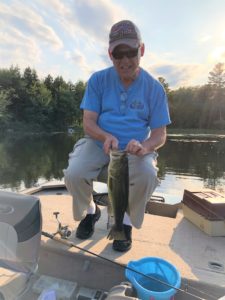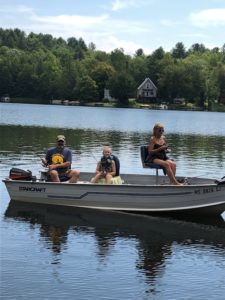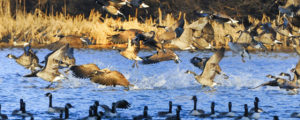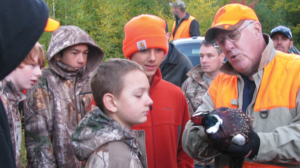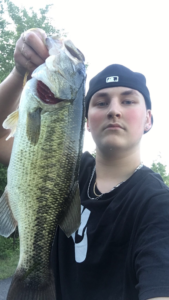That’s according to Jim Whitman of Dalton. On October 5, from sunrise to 3:00 p.m., the seventh annual Vermont State High School Fishing Tournament took place in South Hero, VT. Some 19 boats participated. Along with all Vermont varsity sports programs, this event was overseen by the Vermont Principals Association. Hundreds of students, coaches and fans came from all parts of Vermont to meet at the John Guilmette fishing access on the Inland Sea of Lake Champlain. This section of Champlain, which is east of South and North Hero, Vt, covers 90 square miles.
Abundant fishing opportunities such as weed and gravel beds are there along with depths ranging four to sixty feet hold largemouth and smallmouth bass. Through the practice seasons, students were given safety guidelines before any lines hit the water.
Jim and Bunny Whitman made a trip to watch their son Patrick and their grandson, Hunter, coach Champlain Valley Union High School (CVU) in Hinesburg, VT, compete. Teammates for CVU were Carter Ashley a junior and Hunter’s younger brother, Harrison, a sophomore. 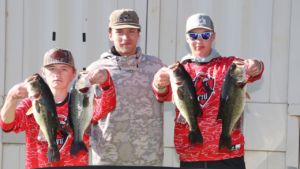
Carter Ashley on left and Harrison Whitman on right holding their bass.,
Volunteer coaches taught students the basics in fishing techniques and accompanied them during tournaments. Many students had little or no fishing experience but, at the end of the season they became proficient and loved the sport. Coaches spend 15 to 20 hours with their students in preparation for tournaments. Part of the time is spent on the shore line of local lakes where casting techniques and lure selection are reviewed. The balance of training is on a boat, searching for likely fish cover and trying their newly learned skills, making successful catches.
“During this tournament, many good things happened for high school competitors, for they all had good luck.” said Jim. Some 114 bass were checked in at the 3:00 p.m. weigh in event which was officially organized by volunteers. “There was lots of enthusiasm from fans who cheered each team as their catches were recorded. While talking with students, they shared information about the best lures for the day which were weighted rubber worms and jigs with tails.”
Some very large fish were registered as Mt Abe High School took lunker honors with a 5.3 lbs. largemouth bass. Each high school team weighed 6 fish and Mt Abe took the state title with a total of 23.84 pounds. CVU was state runner up with 20.95 pounds. The Vermont Fish and Wildlife Department was on hand to release all fish back alive into Lake Champlain.
“At the end of a magical day on Champlain, high school students offered many great fishing stories— and all were true. Indeed, their live wells were full and the sport of high school fishing in Vermont is alive and well.” said Jim Whitman.
Hunter readily gives his dad Patrick, credit for showing him the love of fishing. Although, the coaching season has ended for Hunter, his competition at the college level continues. He is a senior at the University of Vermont and has qualified to represent his college at the National Collegiate Abu Garcia Fishing Tournament.
Be alert for moose and deer while driving
Because fall is the breeding season for both moose and white-tailed deer, MassWildlife reminds motorists to be mindful of increased deer and moose activity, especially during early morning and evening hours. Moose, found in central and western parts of Massachusetts, breed in September and October. White-tailed deer breed from late October to early December.
Moose on the road are especially hazardous. The dark color and height of moose make them difficult to see in low light; moose eyes rarely shine like deer eyes because their eyes are above headlight level. In addition, long legs and heavy top bodies make moose very dangerous to motorists when struck. Observe road signs for moose and deer crossings and slow down. Do not swerve to avoid hitting a deer because it may lead to more risk and damage than hitting the deer. Moose are less likely to move from the road than deer, so stay alert and brake when you see a moose in or near the road.
Deer and moose/vehicle collisions should be reported to the Environmental Police at 1-800-632-8075. In the event of a deer/vehicle collision, the driver or passengers of the vehicle involved (MA residents only) may salvage the deer by bringing it to a MassWildlife Office to be officially tagged.
RIP Grizzly 399
Staying on the subject of animal collisions, did you hear about Grizzly 399? She was a 28-year-old bear known to millions of people and who was an economic force, drawing countless tourists to Jackson Hole, Wyoming. She died on October 22 in a Snake River Canyon vehicle strike. She was identified through ear tags and a microchip, according to the U.S. Fish and Wildlife Service. At the time, the whereabouts of her single cub were unknown. “There appears to be no evidence to suggest the yearling was also involved in the incident, but the service is monitoring the area,” the federal agency stated in a news release.
Unconfirmed reports state that vehicle involved in the collision was “totaled.” The speed limit along Highway 89 in the Snake River Canyon, which connects Jackson to Alpine, is 55 mph. There is no investigation into illegal activity relating to the accident
If you have ever visited the Grand Teton National Park, you may have seen her. She first rose to prominence in 2006, when she began frequenting roadside areas in northern Grand Teton National Park with a three-cub litter. Over the next 18 years, she repeated the pattern every three springs, reemerging with a new batch of cubs. She once raised four cubs — an exceptional rarity — and in 2023, at age 27, emerged with a single cub, making her the oldest female grizzly alive with a cub in the entire Greater Yellowstone Ecosystem. All told, she gave birth to 18 known cubs in the years following her own birth in 1996, according to Justin Schwabedissen, a Grand Teton bear biologist.
“The grizzly bear is an iconic species that helps make the Greater Yellowstone Ecosystem so extraordinary,” Grand Teton National Park Superintendent Chip Jenkins said in a statement. “Grizzly bear 399 has been perhaps the most prominent ambassador for the species. She has inspired countless visitors into conservation stewardship around the world and will be missed.”
September 2024 bear harvest tally is up
There are no grizzlies in Massachusetts, only black bears. According to figures released by MassWildlife, some 188 black bears were taken in the September 2024 bear hunting season, up from 118 taken in the September 2023 season.
The second season of black bear hunting opens on Monday, November 4 and runs through November 23. A blaze orange hat is required on Wildlife Management Areas stocked with pheasants or quail during pheasant season (which is currently under way). Hunting implements allowed are rifles, muzzleloaders and archery only (no shotguns).
Zebra Mussel eDNA recently detected in Pontoosuc Lake
According to the City of Pittsfield, the Department of Conservation and Recreation (DCR) detected eDNA of the invasive species, Zebra Mussels, in the lake during routine monitoring. Environmental DNA, called eDNA, is cellular material that sheds from an organism and is used as an early detector of invasive or rare species.
Zebra Mussels are invasive freshwater mollusks that are the size of a fingernail and have a negative impact on the local environment. They can filter out algae that native species need for food in order to survive and can attach to native mussels. Their name comes from the zig-zagged stripes on their shells.
Currently, the detection of this species only impacts boating operations at Pontoosuc Lake and has no impact on other recreational uses of the lake. The community is asked to refrain from boating on Pontoosuc Lake until there is an ice-over. All docks and buoys should also be removed from the lake and wash all parts of your boats, paddles and other equipment that have been in contact with the water.
In my opinion, if Zebra Mussels can attach to things like boats and paddles, then they probably attach to the feathers of ducks and geese which fly from waterbody to waterbody. Surely, they spread the mussels, too.
Incidentally, Zebra Mussels were also observed in Onota Lake this past August and have been known to exist in Laurel Lake and the Housatonic River in Lee since 2009.

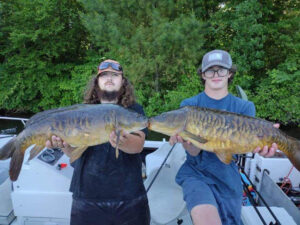
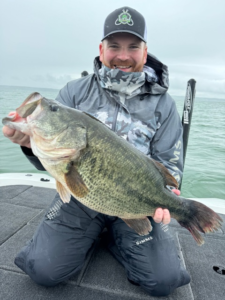 James Bitenbaugh.
James Bitenbaugh.